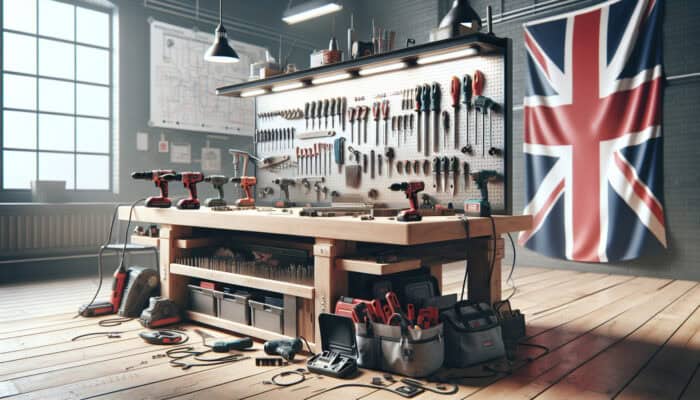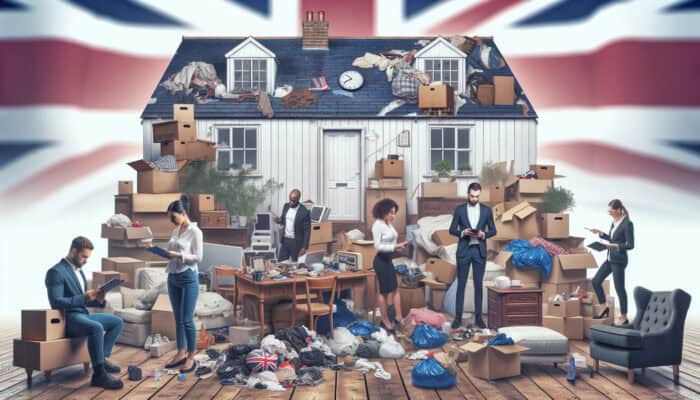Preparing for UK House Clearance
What Items Should You Sort First?

Simple Tips for UK House Clearance: When embarking on a house clearance in the UK, it is vital to begin with items that are straightforward to categorise. Focus on areas like clothing, books, and kitchenware, as these tend to be easier to sort and can help build momentum in your clearance efforts. By tackling one room at a time, you can manage the process more effectively and reduce the overwhelming nature of the task.
Starting with clothing, consider sorting into three categories: keep, donate, and discard. This initial step makes the clearance feel less daunting, and it can be highly rewarding when you see the immediate impact. Next, tackle books; these can often pile up and take up valuable space. Most people have a mix of novels, reference books, and manuals that may no longer serve a purpose. Group them by genre or condition, which can streamline the later decision-making process.
In the kitchen, focus on utensils, appliances, and crockery. The often-forgotten items are those rarely used, such as special occasion dishware or gadgets that have seen little action. Identify what you truly use and love, and eliminate everything else. This targeted approach will not only declutter but will also encourage a more organised living space.
Creating an Inventory List
An effective house clearance starts with an accurate inventory list. This not only serves as a tracking mechanism but also aids in decision-making regarding which items can be kept, sold, donated, or discarded. Utilising a spreadsheet or a dedicated app can significantly enhance this process. Each entry should include details such as the item’s name, condition, intended destination (e.g., charity, sale, recycling), and any additional notes that could assist during the clearance.
Begin your inventory by walking through each room methodically. This allows you to capture everything in one go, ensuring no item is overlooked. Be thorough in documenting the condition of each item, as this information is crucial for resale or donation. For example, if a piece of furniture has minor damage, note it; this transparency is vital for buyers or charities.
Furthermore, as you compile this list, consider incorporating photographs of valuable or sizeable items. This visual reference can be beneficial when selling online or during discussions with charities, ensuring that potential recipients understand what you’re offering. Having a well-organised inventory not only simplifies the clearance but also provides peace of mind, knowing you have a clear picture of what you’re dealing with.
Safety Measures During Clearance
Safety is paramount during any house clearance. With various tasks at hand, it’s easy to overlook the importance of protective gear and safe practices. First and foremost, equip yourself with protective gloves and masks. This is particularly essential when handling dust-laden items or potentially hazardous materials, such as old cleaning products and paints. Protective gear safeguards against cuts, allergic reactions, or respiratory issues.
Proper lifting techniques are crucial to prevent injuries. Always lift with your legs rather than your back, keeping the load close to your body. If an item is too heavy or awkward, don’t hesitate to enlist help or use a dolly. Clearing pathways in your home is another essential precaution; ensure that hallways are free from obstacles to avoid tripping hazards. A clutter-free environment can significantly reduce the risk of accidents.
Lastly, ensure your workspace is well-lit. Dark corners can easily hide dangers, so use bright lights to illuminate areas that are often neglected. Adequate lighting enables better visibility, making it easier to identify hazards or items that require careful handling. By prioritising safety measures, the house clearance process becomes not only efficient but also secure, reducing the chances of injury and ensuring a smoother experience.
Expert Insights on Simple Tips for UK House Clearance

Include Real-World Examples of Successful Clearances
Successful house clearances in the UK showcase creative solutions and practical strategies that can inspire your own efforts. One notable case involved a family home in Brighton, which had accumulated years’ worth of belongings. The family opted for a phased approach, focusing on one room at a time while inviting friends to assist, turning the task into an enjoyable social event. They sorted items into three distinct categories: keep, donate, and recycle, which facilitated a smooth process. The outcome was a significantly decluttered home that felt spacious and welcoming.
Another example is the proactive approach taken by a couple in Manchester who were preparing for a move to a new house. They implemented a 30-day challenge, dedicating each day to clearing a specific category of items, such as electronics, kitchen gadgets, or clothing. Not only did this method keep them motivated, but it also allowed them to see tangible progress each week. By the end of the month, they had successfully cleared out over 60% of their non-essential items, which eased their moving process considerably.
Both examples illustrate the importance of planning and creativity in house clearance. Adopting a structured approach tailored to your unique circumstances, combined with some help from friends or family, can yield exceptional results. Whether through social engagement or setting specific goals, the key is to remain focused, flexible, and open to new ideas that can transform the house clearance experience.
What Are the Common Challenges Faced?
House clearance often comes with its own set of challenges. Recognising these can greatly improve your planning and execution. One of the most significant hurdles is the emotional attachment to items. Many people struggle with letting go of belongings tied to memories, such as inherited furniture or gifts from loved ones. This emotional barrier can significantly slow down the process.
Time constraints can also pose a challenge. Many individuals undertake house clearance while balancing work or family commitments, making it difficult to dedicate sufficient time to the task. As a result, the clearance may drag on, creating frustration and anxiety.
Another common issue is managing logistical difficulties, such as the disposal of large or unwanted items. Knowing where to take these items or how to transport them can present a substantial barrier, particularly in urban settings where space and access can be limited. To aid in overcoming these challenges, consider the following solutions:
- Set realistic goals and timelines to manage emotional ties.
- Allocate specific days or weekends purely for clearance tasks.
- Engage professional clearance services for heavy lifting or transportation.
- Use online marketplaces for quick sales to ease emotional burdens.
By anticipating these challenges and employing effective strategies, you can streamline your house clearance process and alleviate some of the stress associated with it.
Provide Actionable Steps for Efficient Clearance

To achieve a successful house clearance, implementing actionable steps is crucial. Firstly, establish a clear schedule that outlines tasks and deadlines. This will help you maintain focus and ensure that each aspect of the clearance process is addressed systematically and thoroughly. Start by prioritising rooms that are least used, allowing you to create an initial sense of accomplishment that can motivate you to tackle more challenging areas.
Secondly, allocate your resources strategically. This includes gathering the necessary tools, such as boxes, tape, and markers, as well as enlisting the help of family or friends. Having a team can significantly speed up the process, making it more enjoyable and less isolating. When resources are well-managed, you can cover more ground in a shorter time.
Next, make a plan for waste disposal. Research local facilities and know what can be recycled or donated. Having a designated area for items that need to be discarded will make the process smoother and more efficient. Consider arranging for a skip if you anticipate a substantial amount of waste, as this can save trips to the local refuse centre.
Lastly, maintain a flexible attitude throughout the process. Challenges may arise that require you to adjust your plan. Being adaptable will help you navigate these issues more efficiently. By following these actionable steps, you can transform the house clearance into a structured, manageable, and ultimately successful endeavour.
Legal Considerations for UK House Clearance
What Are the Legal Requirements for Disposal?
Understanding the legal requirements for waste disposal during house clearance is vital. The UK has strict regulations regarding waste management, particularly concerning hazardous materials such as batteries, chemicals, and electronic waste. It is crucial to ensure compliance with local laws to avoid penalties and fines. Municipal councils often provide detailed guidance on how to properly dispose of different types of waste, including where to take hazardous items.
When clearing a property, any electrical items must be disposed of according to the Waste Electrical and Electronic Equipment (WEEE) Directive, which mandates that these items be recycled or disposed of responsibly. Failing to adhere to these regulations can lead not only to fines but also to environmental harm. Thus, it’s essential to have a clear grasp of what constitutes hazardous waste and how to handle it legally.
Additionally, if you are considering selling any items, ensure that they comply with safety standards. Items that do not meet these standards could result in liability issues. Furthermore, be cautious about old materials, especially those containing asbestos or lead, which require specialised disposal methods. Always check with your local authority for specific requirements and tips on safe disposal practices.
Obtaining Necessary Permits
In some instances, house clearances may require permits, especially if they involve large-scale projects or significant changes to the property. For instance, if you plan to clear out a substantial amount of waste or are working on a property that will be redeveloped, you may need to consult with your local council to understand the specific regulations in your area.
To obtain the necessary permits, start by contacting your local authority. They can provide information on what is required for your project. This may include permissions for skip hire, especially if the skip will be placed on the street. In many cases, a permit is needed to avoid obstructing public pathways or roads, and failure to obtain one could lead to fines.
It’s also beneficial to engage with any neighbours who might be affected by the clearance, particularly if it involves significant noise or disruption. Keeping them informed can help maintain good relationships and may even result in volunteer assistance during the process. Being proactive about permits and community involvement will streamline the clearance and demonstrate responsible citizenship.
Dealing with Inherited Property
Clearing inherited property can present unique legal considerations, particularly concerning probate and the rights of other heirs. When a property owner passes away, the estate must go through a legal process known as probate, which validates the deceased’s will. Understanding the implications of this process is crucial before embarking on a clearance.
If you are the executor of the estate, your role includes managing the property and its contents. It is essential to communicate openly with other heirs regarding the clearance process, as their rights to the property and its contents must be respected. Failure to do so could lead to disputes, which can complicate the clearance and the overall settlement of the estate.
Consulting a solicitor knowledgeable in probate law can provide valuable guidance on the legal aspects involved in clearing inherited property. They can help navigate complexities such as tax implications, asset division, and other legal requirements. Additionally, they can advise on how to handle items of sentimental value that may be contested among heirs. By taking these steps, you can ensure that the clearance is undertaken responsibly and legally, while also honouring the wishes of the deceased.
How Can You Maximise Value from UK House Clearance?
Selling Items: Where to Start?
When it comes to maximising value during a house clearance, identifying items with resale value is a crucial first step. Start by assessing your belongings for high-value items, such as antiques, collectables, or electronics. Familiarise yourself with local markets and online platforms, such as eBay, Gumtree, or even local auction houses, to determine where these items might fetch the best price.
Begin by researching recent sales to gauge the current market value of similar items. This will inform your pricing strategy and ensure you’re not undervaluing your possessions. For instance, vintage furniture may be highly sought after, while outdated electronics might not yield much return. Consider hosting a garage sale or participating in a local car boot sale to sell items quickly and efficiently.
Additionally, leveraging social media platforms can also be beneficial. Posting items on community groups or local buy/sell pages can generate interest from potential buyers in your area. Be sure to provide clear photographs and detailed descriptions to attract attention. By embracing multiple selling avenues, you can maximise the financial returns from your clearance process.
Donating to Charities in the UK
Donating items to charities is an excellent way to contribute to your community while decluttering your home. Many charities across the UK accept a wide range of items, including furniture, clothing, and household goods. Before donating, it’s essential to research local charities to understand their specific needs and guidelines.
Some charities may have restrictions on the types of items they can accept. For example, while one charity may welcome furniture donations, another may only accept clothing. Contacting the charity beforehand can help ensure that your donations are both useful and appreciated. Reputable organisations like the British Heart Foundation or Oxfam often have specific collections for larger items, making it easy to donate while supporting a good cause.
Moreover, consider the potential tax benefits of donating items. In some cases, you may be able to claim a tax deduction for your contributions, depending on the item’s value. Keeping receipts and documentation of donations will be beneficial should you choose to claim this on your tax returns. Donating not only aids in house clearance but also supports charitable initiatives, making it a win-win situation.
What Are the Tax Implications of Selling?
Understanding the tax implications of selling items during a house clearance is essential to ensure compliance with HM Revenue and Customs (HMRC) regulations. Generally, if you sell personal items for less than their original purchase price, you won’t incur capital gains tax. However, if you sell items for a profit, such as collectables or antiques, the gains may be subject to tax.
Keeping accurate records of sales, including dates, prices, and original costs, can help clarify whether any profits fall above the allowable exemptions. For instance, as of the current regulations, individuals can make up to £12,300 in profits from asset sales without incurring capital gains tax. Also, if you are running a business selling items, different tax rules may apply, and you would need to register as a trader.
It’s advisable to consult a tax advisor to help navigate any complexities and ensure you’re taking advantage of legal allowances. They can provide guidance on how to report your sales income accurately and what records to keep. By being informed about the tax implications, you can optimise your financial outcomes and avoid any unexpected liabilities.
Hiring Professional Clearance Services
Hiring professional house clearance services can be a game-changer, particularly for large or complex clearances. Professional services offer a wealth of expertise, efficiency, and convenience, making them an attractive option for many homeowners. Start by researching reputable companies in your area and examining customer reviews to gauge their reliability and quality of service.
When considering a professional service, it’s important to compare not just prices, but also the range of services offered. Some companies may provide additional options, such as rubbish removal, recycling, and even cleaning services post-clearance. Understanding the full scope of what’s included in their fees can help you make an informed decision.
Once you’ve selected a few candidates, arrange for quotes. Be transparent about your needs and the scale of the clearance, as this will help them provide accurate estimates. Having professionals handle the heavy lifting and logistics can save you significant time and effort, allowing you to focus on other aspects of your move or home transition. Ultimately, hiring experts can lead to a more seamless and stress-free clearance experience.
Recycling and Disposal Options
When clearing a house, it’s important to consider recycling and disposal options for items that cannot be sold or donated. The UK has robust systems in place for handling waste, and being mindful of environmentally friendly practices can significantly reduce your ecological footprint. First, identify which materials can be recycled. Common recyclable items include cardboard, paper, plastics, and metals. Many local authorities provide recycling centres where these materials can be disposed of responsibly.
For larger items, such as furniture and appliances, check with your local council about bulk waste collection services. Some councils offer scheduled pickups for larger items, making it easier to dispose of them without the hassle of transport. Alternatively, consider donating them to charities that can repurpose or resell them.
Another option is to look into upcycling, which involves transforming old furniture or items into new, functional pieces. Not only does this reduce waste, but it also allows for creative expression. Research local workshops or community groups that focus on upcycling to find inspiration and resources. By being proactive about recycling and disposal, you ensure a responsible clearance process that supports environmental sustainability.
Trusted Strategies for Simple Tips for UK House Clearance
Offer Expert Analysis on Time Management
Effective time management is crucial for a successful house clearance. Developing a structured plan helps prioritise tasks and allocate time efficiently. Start by creating a detailed schedule that outlines what you will tackle each day and stick to it as closely as possible. Breaking the clearance down into manageable chunks can alleviate feelings of overwhelm and keep you motivated.
Prioritisation is key; focus on rooms that have accumulated the most clutter or those that are least essential to your daily life. This will provide a sense of accomplishment early on, encouraging you to move on to more challenging areas. Additionally, consider setting timers for each task. For example, dedicate 30 minutes to sorting items in a specific room before taking a break. This method can enhance productivity and help maintain your energy levels.
Incorporating professional services for particularly complex tasks can also save valuable time. Hiring experts for heavy lifting or disposal can free you up to focus on sorting, organising, and making decisions about your belongings. Alternatively, if you have a tight schedule, consider enlisting family or friends to assist during peak times. By employing effective time management strategies, you can streamline your house clearance and achieve your goals more efficiently.
What Are the Best Practices for Sorting Items?
Adopting best practices for sorting items during a house clearance is essential for efficiency and effectiveness. Begin with a clear plan that categorises items into distinct groups: keep, donate, sell, and discard. This systematic approach allows for a more organised and less overwhelming experience. Use boxes or bags labelled with each category to keep everything orderly.
Labelling is crucial, not just for your sanity, but also for others who may assist. Clearly marked items will ensure everyone understands where things belong, which can help avoid confusion. Additionally, consider adopting a ‘one in, one out’ rule, meaning for every item you keep, you should let go of another. This practice reinforces decision-making and helps maintain a clutter-free environment.
Another effective method is to tackle items based on frequency of use. Start with items used less frequently, such as seasonal decorations or rarely used appliances, as these can be easier to part with. As you gain confidence, move on to more commonly used items. By integrating these best practices into your clearance process, you can enhance efficiency, reduce stress, and create a more organised living space.
- Sort items into clear categories: keep, donate, sell, discard.
- Use labelled boxes to maintain organisation.
- Adopt the ‘one in, one out’ rule for better decision-making.
- Tackle infrequently used items first to build confidence.
- Involve others to share the workload and gain different perspectives.
- Set clear goals for each sorting session to maintain focus.
- Document valuable items for selling or donating.
- Regularly revisit your decisions to ensure you’re content with your choices.
Engaging Professional Clearance Services
For large or complex clearances, engaging professional clearance services can alleviate much of the stress involved. These experts bring a wealth of experience and can efficiently manage the heavy lifting, logistics, and disposal of items. Begin by researching reputable clearance companies in your area, paying close attention to customer reviews and testimonials. This due diligence will help ensure you choose a reliable service that meets your needs.
Once you have narrowed down your options, consider contacting several companies for quotes. Be clear about the scope of your clearance and ask questions about their services, including waste disposal practices and any additional costs that may arise. Some professionals may offer comprehensive packages that include packing, sorting, and cleaning, providing a one-stop solution for your clearance needs.
Moreover, don’t hesitate to communicate your unique requirements. Professional clearance services are accustomed to handling various situations and can tailor their approach accordingly. By engaging their expertise, you can experience a smoother, more efficient house clearance process, ultimately saving time and reducing stress.
How to Dispose of Items Responsibly
Disposing of items responsibly during a house clearance is crucial for environmental sustainability. Start by identifying which items can be recycled, reused, or donated. Familiarise yourself with local recycling regulations and find out which items can be accepted at your local recycling centre. Many councils provide detailed guidelines on what constitutes recyclable material, ensuring that you’re complying with waste management practices.
For items that are not suitable for recycling, consider repurposing them creatively or donating them to charities that can benefit from your unwanted goods. This approach not only reduces waste but also provides others with valuable items they may need. Many local charities offer collection services, making it more convenient to donate larger items such as furniture.
Engaging in eco-friendly disposal methods is not only morally responsible but can also contribute to a greener community. For hazardous waste, such as chemicals and batteries, locate designated disposal facilities that adhere to UK guidelines for safe disposal. By prioritising responsible disposal practices during your house clearance, you play a vital role in promoting environmental stewardship and reducing your carbon footprint.
Environmental Impact of UK House Clearance
Reducing Waste During Clearance
Reducing waste during a house clearance is essential for minimising the environmental impact of your efforts. Start by thoroughly assessing items for their potential for reuse or recycling. Many items, such as clothing or household goods, can be donated or sold, extending their lifecycle and preventing them from ending up in landfills. By being mindful of what you dispose of, you can significantly reduce overall waste.
Investigate local recycling facilities in your area. These facilities often accept a wide range of materials, from paper and plastics to electronics and metal. Understanding your local recycling policies will ensure you’re disposing of materials responsibly. Additionally, consider upcycling items that cannot be reused in their current form. This creative practice not only reduces waste but also offers the opportunity to give new life to old items, such as transforming a worn-out chair into a stylish garden feature.
Furthermore, be proactive about organising a community swap event or garage sale. This allows others to benefit from items you no longer need, fostering a sense of community while reducing waste effectively. By taking these initiatives, you can make a positive contribution to your environment and inspire others to adopt sustainable practices during their clearances.
What Are the Benefits of Eco-Friendly Clearance?
Engaging in eco-friendly clearance practices offers numerous benefits, both for individuals and the environment. Primarily, eco-friendly clearance significantly reduces environmental impact by promoting responsible waste management and sustainability. By recycling and donating items rather than discarding them, you help conserve resources and reduce the strain on landfill sites.
Cost-effectiveness is another advantage of eco-friendly practices. Many recycling initiatives and charitable organisations operate with minimal fees or no costs at all. This can lead to savings on disposal fees, particularly if you’re managing a large clearance. Furthermore, entities supporting eco-friendly disposal often provide incentives for donations, enabling you to contribute to charitable causes while potentially benefiting from tax deductions.
Additionally, adopting eco-friendly clearance practices can foster a sense of community awareness and responsibility. By leading by example, you encourage others to consider their environmental impact and engage in similar practices. This ripple effect can cultivate a community culture focused on sustainability, making eco-friendly clearance a catalyst for broader societal change. Ultimately, by prioritising eco-friendly methods during house clearance, you not only benefit personally but also contribute positively to the world around you.
Disposing of Hazardous Materials Safely
Disposing of hazardous materials safely is paramount during a house clearance. Such materials can include old chemicals, paint, batteries, and electronic waste, all of which require special handling to ensure safety and compliance with local regulations. Begin by identifying any hazardous items in your home and consult your local authority’s guidelines for their disposal. Many councils provide specific instructions and designated facilities for hazardous waste.
For items like paint or chemicals, many local councils offer periodic collection events or designated drop-off points. Always follow the safety guidelines outlined by local authorities to ensure safe handling and disposal. For electronic waste, check for local recycling programs that accept old televisions, computers, and other devices, as these often contain harmful components that should not be sent to landfills.
If you are unsure about how to dispose of a specific hazardous item, do not hesitate to contact your local waste management facility for guidance. They can provide detailed information on proper disposal methods, ensuring that you adhere to environmental regulations while protecting public safety. By taking the time to dispose of hazardous materials safely, you contribute to a healthier environment and safeguard your community from potential hazards.
FAQs
What should I do with sentimental items during house clearance?
Decide whether to keep them or take photos to cherish memories. Consider sharing with family members who may value them.
How long does a house clearance usually take?
The duration varies based on property size and the number of items to sort, but expect it to take from a few days to a couple of weeks.
Can I hire a professional service for a small clearance?
Yes, many services cater to small clearances and can provide tailored packages for your specific needs.
What if an item is too heavy to lift?
Consider hiring professional movers or seeking assistance from friends. Use tools like dollies for safer transport.
Are there any items that I cannot donate?
Yes, most charities do not accept items that are broken, heavily stained, or pose safety risks. Always check first.
How can I find the value of antiques before selling?
Research online auction sites, consult antiques experts, or visit local antique shops for insights on pricing.
Is it necessary to have a permit for a skip?
Yes, if placing a skip on a public road or pavement, you will typically need to secure a permit from your local council.
What is the best way to dispose of expired chemicals?
Contact your local waste disposal facility for guidance and follow their instructions for safe disposal.
Can I sell items that I inherited?
Yes, but ensure you are legally entitled to sell the items. Consult with a solicitor if unsure about inheritance rights.
How can I help reduce waste during my clearance?
Focus on recycling, donating, and upcycling where possible, and consult local facilities for responsible disposal methods.






